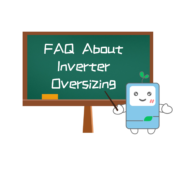Senergy Lecture 01 | FAQ About Inverter Oversizing
Q: What is oversizing?
A: In a solar system, when the installed solar panel capacity is higher than the rated capacity of the inverter, we refer it as inverter oversizing.
To understand solar system oversizing, we introduce the concept of PV/inverter ratio. This ratio is the relationship between the PV module rating (Pdc) and inverter output power rating (Pac): R=Pdc/Pac. When ‘R’ is greater than 1, it indicates that the system is oversized.
Q: Why oversize solar inverters?
A: The purpose of oversizing is to ensure that the system’s output power reaches its rated capacity.
In a real-world environment, various factors such as sunlight intensity, system loss, module degradation, and others affect the system’s efficiency from the modules to the inverter output. If a 1:1 capacity ratio is followed, the system’s actual output power will often fall below the rated capacity. Therefore, to ensure the investment benefits of the power station, it is recommended to appropriately increase the module capacity to achieve an output power that meets the rated capacity.
Q: How to oversize solar inverters?
A: There are typically two approaches to oversizing (increasing the PV/inverter ratio):
- Compensatory Oversizing: This method involves moderately increasing the module capacity ratio to compensate for energy losses during transmission, ensuring the system reaches its rated output power.
- Proactive Oversizing: This approach actively extends the inverter’s full-load operating time, balancing the increased cost of additional modules with the system’s power generation revenue to achieve the lowest possible cost per kilowatt-hour.
Q: What are the benefits of oversizing?
A: The benefits include:
- Ensuring high power generation efficiency under varying sunlight intensities.
- Increasing the utilization rate of PV modules.
- Reducing power output fluctuations, resulting in stable and smooth output, and improving grid compatibility.
- Mitigating the reduction in power generation hours due to module degradation.
- Increasing the shipment of modules and mounting racks by enhancing the capacity ratio.
Q: Is a higher oversizing ratio always better?
A: No.
With the introduction of energy storage products, the power of the modules must meet both the system’s output power and the energy demand for battery charging. As a result, the inverter oversizing ratio has increased from 150% to 200% or even higher. However, a higher oversizing ratio is not always advantageous. A higher ratio means longer periods of full-load operation for inverters, requiring them to handle greater stress and improved cooling performance, which in turn raises system investment costs. Therefore, it is important to balance the additional system costs with the power generation revenue and choose an appropriate oversizing ratio to achieve the lowest cost per kilowatt-hour.
Conclusion
Moderately increasing the capacity ratio of modules and inverters, and appropriately oversizing the system, can significantly improve inverter utilization and enhance the economic efficiency of the power station. Optimally designing the system capacity ratio is crucial for maximizing the economic performance of the solar system. Specific calculations must be tailored to various factors such as solar resource availability, local temperatures, electricity price levels, and more.




